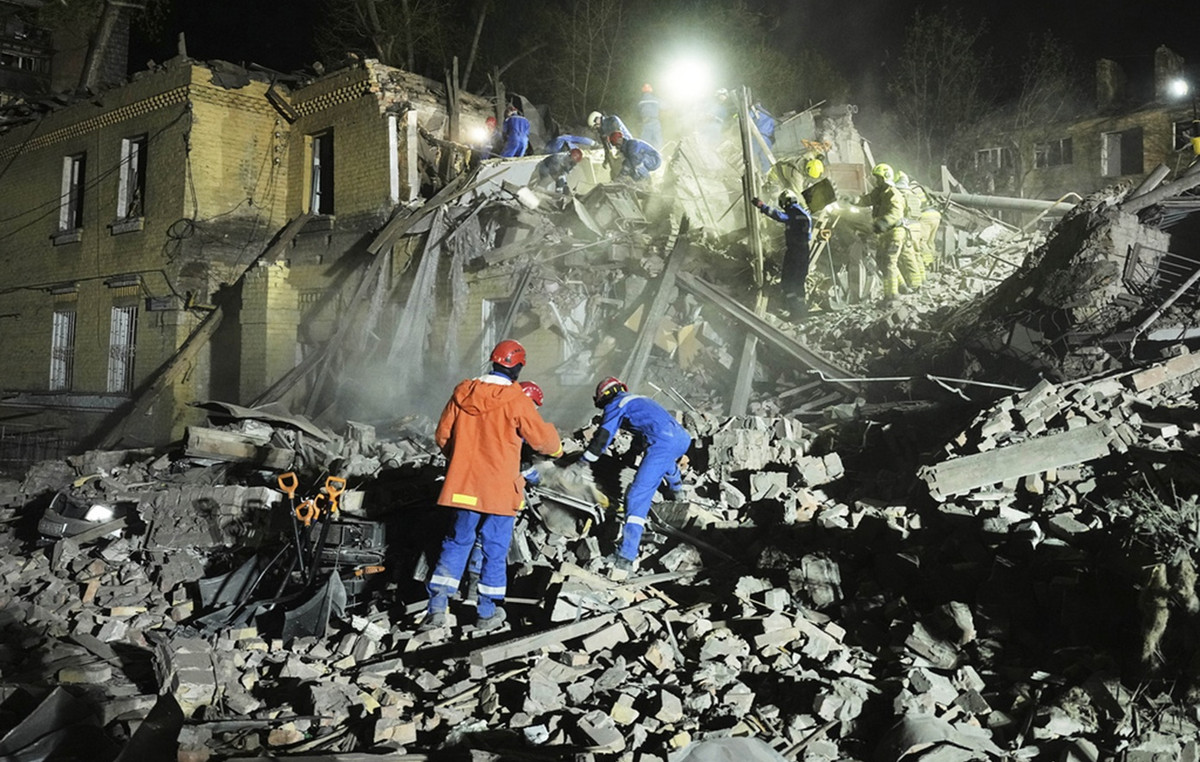Tunnels built by Hamas in Gaza are likely to be a key target of the Israeli offensive triggered by the October 7 terrorist attack in southern Israel.
Hamas is believed to be harboring a considerable number of fighters and weapons underground, along with an unspecified number of the estimated 239 hostages the Israeli government says Hamas has taken.
One expert on tunnels is Dr. Daphné Richemond Barak, who wrote “Underground War,” a book that, until three weeks ago, was of great interest to students of military history.
A professor at the Lauder School of Government, Diplomacy and Strategy at Reichman University in Herzliya, Israel, she founded the International Working Group on Underground Warfare.
During the Vietnam War, the Viet Cong extensively used tunnels to hide and fight US troops, while during World War I, the British launched large-scale attacks from tunnels against the Germans, such as one at the Battle of Messines. , in Belgium, in 1917, which killed around 10,000 German soldiers.
Richemond Barak began writing his book in 2013, when a sophisticated cross-border tunnel about a mile long and up to 18 meters deep was dug by Hamas from the Gaza Strip into Israeli territory, where it was later discovered .
Over the next decade, she conducted extensive research into the Hamas tunnel system, as well as the underground network built by Hezbollah.
It will be important to understand the latter group if regular exchanges of fire this month between the Iran-backed militant group and Israel escalate into a war on Israel’s northern border with Lebanon.
Peter Bergen: What’s it like inside a Hamas tunnel? What’s the sensation? What’s the smell?
Daphne Richemond Barak: You find yourself in this dank, dark, scary, claustrophobic environment where you literally never know what’s coming next.
Additionally, it can get very cold at night and be suffocating. There’s not much air. If you’re going to be there for a long time, you need oxygen, especially if you’re a soldier. And in some tunnels you have to duck because they are not very high.
When you enter one of these tunnels too quickly, you completely lose your sense of direction – where you came from, where you are going. It’s easy to become completely disoriented and confused quickly, and some people have big problems with this.
In addition to the claustrophobia, you lose track of time, so you may feel like you’ve been there for two hours, but in reality it’s only been 20 minutes.
Bergen: How is Hamas communicating inside these tunnels? Because presumably radio communication and that sort of thing doesn’t work.
Richemond Barak: So cell phones, of course, are out of the question. It has implications for Hamas, which, in order to exploit this network of tunnels, needs to find a way to communicate with each other, but it also has implications for the Israel Defense Forces (IDF). If they enter the tunnels, how will they maintain communication between the underground units, but also with the forces above ground?
Bergen: The tunnel training center that the Israelis have – tell us the history of that and how it works.
Richemond Barak: After the warning of Operation Protective Edge in 2014 (Israel’s campaign against Hamas involving air and ground attacks that lasted 50 days), Israel began to look at the issue of underground tunnels as a strategic issue.
Israeli soldiers entered the Hamas tunnels during Operation Protective Edge, and were untrained and unequipped, and there was fighting in the tunnels.
As a result of Operation Protective Edge, Israel has taken a series of measures not only for tunnel detection techniques, but also for training in this underground environment.
They have created elite units that are well versed in all aspects of underground warfare.
Additionally, they began basic underground warfare training for soldiers so they would know how to bypass or neutralize a tunnel and then what equipment would be needed if they had to go down there. You need to be prepared for a different type of environment, but also a different type of fight.
The IDF also used simulators where you put on these virtual reality glasses, which would take you into the virtual tunnel. But it’s not the same as being in a tunnel. To try it, you need to be inside a real tunnel, and so one of the challenges you face is decision making: what do you do if you find a door? Do you break down the door? How do you break down the door?
Bergen: Why tunnels?
Richemond Barak: Why tunnels? Tunneling is a time-consuming and resource-intensive type of work. It takes a long time to dig. You need to keep the location of the tunnels secret. So the point is that there is a huge investment there. When you enter the tunnel, this investment hits you in a very powerful way, especially in the Hezbollah tunnels, because they are close to the northern border of Israel, where it is the hard rock that you must cross – or, more precisely, in this case – dig.
Tunnels neutralize the military capabilities of a more sophisticated enemy. It serves as a great equalizer between the two sides.
Bergen: Regarding Gilad Shalit, the Israeli soldier who was held hostage by Hamas between 2006 and 2011. Reading your book, I realize that the tunnels played an important role when he was captured. Can you explain how this happened?
Richemond Barak: What Hamas did was use smuggling tunnels to take Shalit into captivity, and it was a surprise because that was not what these tunnels had been used for until then. And Israel was surprised and suddenly realized, wait a second, maybe we should pay more attention to these tunnels because the kidnapping of an IDF soldier is considered a major strategic event. After all, Israel had to release around 1,000 Palestinian prisoners to recover Shalit.
Bergen: For the Israelis, one of their main concerns now must certainly be that these tunnels could be used to take additional soldiers hostage.
Richemond Barak: For sure. Kidnappings of soldiers are always seen in Israel as a type of strategic event. Therefore, additional kidnappings would be devastating at this stage.
Bergen: What will be the role of tunnels in this war?
Richemond Barak: Israel understands that to eliminate or destroy Hamas’ military capabilities, this underground network of tunnels, where Hamas has its arsenal and command and control, needs to be eliminated. I won’t say completely eliminated because I believe it’s impossible. But it needs to be a significant blow to this capability, much more severe than what was dealt during Operation Protective Edge.
It is a terrain that Hamas knows so well, where it maneuvers with ease and does not get lost inside its tunnels. It’s not much different than what ISIS did in Mosul, Iraq, or Raqqa, Syria; This was ISIS’s measure of last resort when it came to combating the coalition fighting ISIS. The fight moved underground.
But to achieve the strategic objective, which is to eliminate Hamas’ underground military infrastructure, the way to do it is not through an above-ground incursion.
Bergen: Does Israel use dog force inside tunnels?
Richemond Barak: Yes, dogs are trained to enter this environment.
Bergen: What about robots?
Richemond Barak: What you need for this robot is the ability to walk in wet terrain because there is usually water at the bottom of a tunnel. It’s humid. You need them to be able to climb stairs or ladders.
Bergen: What else might work?
Richemond Barak: The high-pressure water would cause the tunnel structures to collapse. It attacks the tunnel structure in a much more significant way than just flooding it with normal water. Remember that the soil can absorb some of the water.
Now, there could be civilians in the tunnels and, most likely, there could be hostages; you need to clear the tunnels first. If they are inside the tunnel, it will obviously be more difficult. And I wouldn’t use high pressure water.
Bergen: What about Hezbollah’s tunnels if the war escalates?
Richemond Barak: To illustrate how difficult it is to detect tunnels, see Operation Northern Shield. This is the operation that Israel launched in 2018 to expose the cross-border tunnels that Hezbollah dug.
This occurred after Israel drastically improved its detection techniques, but this occurs in a different type of terrain because Hezbollah has to tunnel through hard rock, whereas in Gaza it is soft ground.
It took Israel six weeks – even though there were no hostilities – to detect six tunnels.
Even if you have intelligence, even if you have narrowed down the area where you suspect the tunnels are located, even if you have the most sophisticated and available means of detecting tunnels, it will still take a considerable amount of time to find the tunnels.
See also – Israel says 240 people are Hamas hostages in Gaza
Source: CNN Brasil
Bruce Belcher is a seasoned author with over 5 years of experience in world news. He writes for online news websites and provides in-depth analysis on the world stock market. Bruce is known for his insightful perspectives and commitment to keeping the public informed.







